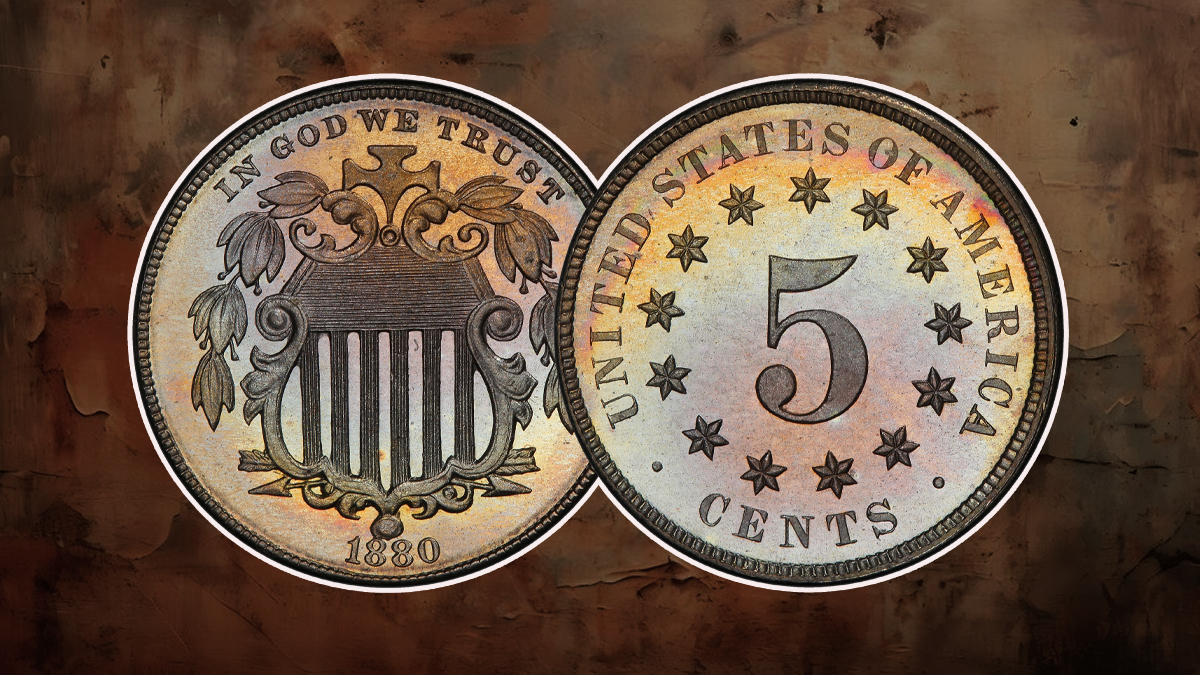
The Shield nickel was the first U.S. five-cent coin made of copper-nickel, introduced from 1866 to 1883. Designed by James B. Longacre, it was the first five-cent piece referred to as a “nickel.” Before this, five-cent coins were made of silver and called half dimes.
History of 1880 Shield Nickel
Silver half dimes had been minted since the late 1700s but disappeared during the Civil War due to economic turmoil. The U.S. Mint introduced low-denomination copper-nickel coins to replace them. Industrialist Joseph Wharton, who had interests in nickel mining, influenced Congress to mandate the use of nickel in the new five-cent coin. Consequently, Congress required the coin to be heavier to allow more nickel usage, leading to the introduction of the Shield nickel in 1866.
Mint Director James Pollock initially opposed nickel coins but later supported them. He aimed for a five-cent coin to replace the five-cent note and prevent counterfeits. The bill passed in 1866, and the new coin became legal tender for amounts up to one dollar, redeemable for banknotes in large quantities.
Specification:
Designer: James Barton Longacre
Edge: Plain
Diameter: 20.50 Millimeters
Weight: 5.00 Grams
Mintage: 3,955
Mint: Philadelphia
Metal: 75% Copper, 25% Nickel
Design
James B. Longacre quickly created the design for the new coin. The obverse (front) of the coin featured a shield symbolizing strength and unity, inspired by the Great Seal of the United States. The reverse (back) showed the number 5 surrounded by stars and rays. This design proved hard to produce and received criticism for its unattractive appearance and resemblance to Confederate symbols. In 1867, the rays were removed to improve production.
Production
Despite production issues, the Shield nickel was minted until 1883. In 1876, minting stopped due to an oversupply of low-denomination coins and resumed only in small quantities until 1881. The Shield nickel was replaced by the Liberty Head nickel in 1883.
The Shield nickel’s design symbolizes a unified America. The shield represents defense and unity, with the laurel branches symbolizing victory. The stars and rays design on the reverse was mechanical, not artistic, added through punching characters and devices into the metal.
Rarity and Condition of the 1880 Shield Nickel
The 1880 Shield nickel is one of the rarest coins in the Shield nickel series. Only about 16,000 to 21,000 were minted, and nearly all of them entered circulation and were eventually lost. Experts estimate that only about 100 circulation-strike coins exist today in any grade, making them far rarer than Proof versions from the same year.
Coin Features and Diagnostic Markers
This particular 1880 Shield nickel is graded MS-66 by PCGS, which stands for Mint State 66, indicating an exceptionally well-preserved coin. It features vibrant, satin-white surfaces and a full, sharp strike. To confirm the coin’s authenticity and that it was struck for circulation, collectors look for specific die markers:
- Doubling on the Upper Left Side of the First “S” in STATES – A slight punching or doubling.
- Raised Lump Below the Second “T” in STATES – This lump is from a die pit or rust.
- Engraver’s Scratch or Die Line – A thin line extends up from the center of a dentil located below and between the “T” and “S” in CENTS.
Value of 1880 Shield Nickel
Given its rarity and high grade, this 1880 Shield nickel is highly sought after by collectors. As one of the finest known examples, certified as MS-66 by PCGS, it holds significant value. The market value of such a coin can reach thousands of dollars, often commanding premium prices at auctions due to its exceptional condition and scarcity.
Also Read – 1916 Buffalo Nickel Doubled Die Obverse: A Collector’s Guide
Conclusion
The Shield nickel, a significant coin in U.S. history, marked the transition from silver to nickel in five-cent pieces. Despite its production challenges and criticisms, it remains a collectible item today. The 1880 Shield nickel, one of the rarest in the series, holds significant value for collectors, especially in high grades like MS-66. This coin represents a piece of American history and numismatic interest, making it highly sought after at auctions.
